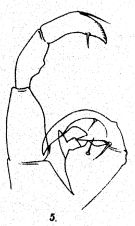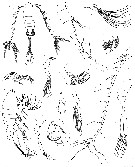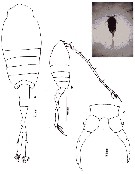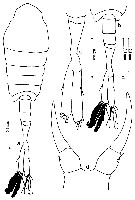|
|
 |
Fiche d'espèce de Copépode |
|
|
Calanoida ( Ordre ) |
|
|
|
Diaptomoidea ( Superfamille ) |
|
|
|
Tortanidae ( Famille ) |
|
|
|
Tortanus ( Genre ) |
|
|
|
Tortanus ( Sous-Genre ) |
|
|
| |
Tortanus (Tortanus) gracilis (Brady, 1883) (F,M) | |
| | | | | | | Syn.: | Corynura gracilis Brady, 1883 (p.71, figs.F,M); Giesbrecht, 1892 (p.71, 525); Wolfenden, 1911 (p.364) | | | | Ref.: | | | Giesbrecht & Schmeil, 1898 (p.158); Wolfenden, 1905 (1906) (p.1026, Rem.); A. Scott, 1909 (p.190, Rem.); Früchtl, 1924 b (p.64); Sewell, 1912 (p.354, 377: Rem.); 1914 a (p.248, Rem.F,M, fig.M); Steuer, 1926 a (p.58, figs.F,M, chart); Sewell, 1932 (p.398); Farran, 1936 a (p.122); Krishnaswamy, 1953 (p.140, fig.F); Kasturirangan, 1963 (p.66, figs.F,M); Chen & Zhang, 1965 (p.117, figs.F,M); Saraswathy, 1966 (1967) (p.85); Zheng & al., 1982 [p.95, Figs.F); Ohtsuka, 1992 a (p.265); Chihara & Omori, 1997 (p.924, Pl.186: F,M); Ohtsuka & Reid, 1998 (p.782, 796: figs.M); Bradford-Grieve & al., 1999 (p.886, 963, figs.F,M); Conway & al., 2003 (p.142, figs.F,M, Rem.); Mulyadi, 2004 (p.167, figs.F, Rem.); Phukham, 2008 (p.110, figs.F); Blanco-Bercial & al., 2011 (p.103, Table 1, Biol. mol, phylogeny) |  issued from: Q.-c Chen & S.-z. Zhang in Studia Marina Sinica, 1965, 7. [Pl.52, 9-11]. Female (from E China Sea): 9, habitus (dorsal); 10, P5 (posterior). Male: 11, habitus (dorsal)
|
 issued from: Q.-c Chen & S.-z. Zhang in Studia Marina Sinica, 1965, 7. [Pl.53, 1]. Male: 1, P5 (posterior).
|
 issued from : S. Ohtsuka & J.W. Reid in J. Crustacean Biol., 1998, 18 (4). [p.796, Fig.11, C-D]. Male: C, P5 of 5th copepodid stage; D, P5 of adult. Scale bar in mm. Nota: Note newly formed P5 of adult stage within preceding stage (thick dotted line in C). Arrows in C and D indicate a presumed homologous seta. The structure of the adult male P5 of Tortanus, in particular the right leg, has not been clearly understood. Giesbrecht (1892) thought that the right leg was composed of a coxa, basis, and 2-segmented exopod (the exopod forming a chela). Through observations of the 5th copepodid stages of males of several species, we have concluded that this system is incorrect. The most important tool to trace the homology of segments and elements through development is to examine the newly formed appendage under the cuticle of the preceding stage (see in Hulsemann, 1991, p.105). The 2nd segments of the adult male P5, with an outer (or posterior) seta on each side, are referred to as the basis. Both coxae and the intercoxal sclerite are completely fused to form a common base in the 5th and adult stages. The segment (s) distal to the basis were called the exopod (Giesbrecht,1892; and others) or endopod (Bowman, 1971). Presumably the process on the right basis of the 5th copepodid stages of T. discaudatus and T. derjugini corresponds to the vestigial endopod.
|
 Issued from : R.B.S. Sewell in Spolia Zeylanica, 1914, 9. [Pl.XXI, Fig.5]. Male (from Gulf of Mannar): P5. Nota: Right A1 16-segmented (segments 1-5, 19-21, and 22-25 fused). Proportional lengths of urosomites and furca as 14:14:11:8:15:72. Sewell points to the characteristics female following: A1 17-segmented (segments 1-7, and 13-14, apparently fused. P5 asymmetrical, but the degree of asymmetry is very slight (not comparable to that in T. forcipatus.
|
 issued from : Z. Zheng, S. Li, S.J. Li & B. Chen in Marine planktonic copepods in Chinese waters. Shanghai Sc. Techn. Press, 1982 [p.95, Fig.55]. Female: a, habitus (dorsal); b, urosome (lateral); c, idem (ventral); d, P1; e, P5. Scale bar in mm.
|
 Issued from : G.S. Brady in Rep. Scient. Results Voy. Challenger, Zool., 1883, 8 (23). [Pl.XXXIII]. As Corynura gracilis. Female: 2, habitus (lateral); 3, A1; 5, A2; 6, Md; 7, Mx1; 8, Mx2; 9, Mxp; 10, one of the swimming leg; 12, P5; 13, urosome; 14, same (lateral). Male: 1, habitus (ventral); 4, denticulated portion of right A1; 11, P5.
|
 issued from : N. Phukham in Species diversity of calanoid copepods in Thai waters, Andaman Sea (Master of Science, Univ. Bangkok). 2008. [p.193, Fig.67]. Female (from W Malay Peninsula): a-b, habitus (dorsal and lateral, respectively); c, P5. Body length after the drawing: F = 1.882 mm.
|
 issued from : Mulyadi in Published by Res. Center Biol., Indonesia Inst. Sci. Bogor, 2004. [p.168, Fig.93]. Female (from 06°10'S, 106°00'E): a, habitus (dorsal); b, last thoracic segment and urosome (dorsal); c, psterior region of urosome (dorsal); d, P5.
| | | | | Ref. compl.: | | | Gurney, 1927 (p.158); Sewell, 1948 (p.324); C.B. Wilson, 1950 (p.346); Wickstead, 1959 (p.69, Rem.: p.72); Wickstead, 1962 (p.546, food & feeding); Ganapati & Shanthakumari, 1962 (p.9, 16); Delalo, 1968 (p.138); Patel, 1975 (p.660); Ikeda, 1977 d (p.263, feeding); Chen Q-c, 1980 (p.795); Skjoldal, 1981 (p.119, adenylate energy); Chen Q., 1983 (p.133); Binet, 1984 (tab.3); 1985 (p.85, tab.3); Madhupratap & Haridas, 1986 (p.105, tab.1); Sarkar & al., 1986 (p.178); Othman & al., 1990 (p.561, 564, Table 1); Mitra & al., 1990 (fig.3); Dai & al., 1991 (tab.1); Shih & Young, 1995 (p.74); Ramaiah & Nair, 1997 (tab.1); Mauchline, 1998 (tab.8); Wong & al, 1998 (tab.2); El-Serehy & al., 2001 (p.116, Table 1: abundance vs transect in Suez Canal); Rezai & al., 2004 (p.490, tab.2); Dur & al., 2007 (p.197, Table IV); Ohtsuka & al., 2008 (p.115, Table 4, 5, Rem.: in Tamashima Harbor and Dokai Bay); Tseng L.-C. & al., 2008 (p.153, Table 2, occurrence vs geographic distribution); Tseng L.-C. & al., 2008 (p.46, table 2, abundance vs moonsons, table 3: indicator species); Rakhesh & al., 2008 (p.154, Table 5: abundance vs stations); Cornils & al., 2010 (p.2076, Table 3); Maiphae & Sa-ardrit, 2011 (p.641, Table 2, 3, Rem.); Saitoh & al., 2011 (p.85, Table 5); Rakhesh & al., 2013 (p.7, Table 1, abundance vs stations); Jagadeesan & al., 2013 (p.27, Table 3, seasonal variation); El-Serehy & al., 2013 (p.2099, Rem.: p.2101); Nakajima & al., 2015 (p.19, Table 3: abundance); Ohtsuka & Nishida, 2017 (p.565, Table 22.1); | | | | NZ: | 8 | | |
|
Carte de distribution de Tortanus (Tortanus) gracilis par zones géographiques
|
| | | | | | | | | | Loc: | | | off Ascension Is. (in Wolfenden,1911), Gulf of Suez, Suez Canal, Red Sea, Madagascar (Nosy Bé), Seychelles, Indian, India (Saurashtra coast, Bombay, Lawson's Bay, Madras, Gulf of Mannar, Plak Bay, Mandarmani, Godavari region, Kakinada Bay, Hooghly estuary), W Malay Peninsula (Andaman Sea), Straits of Malacca, G. of Thailand, off Sigapore, Indonesia-Malaysia, W Java (off Labuan), Tioman Is., SW Celebes, Philippines, Hong Kong, China Seas (Yellow Sea, East China Sea, South China Sea, Xiamen Harbour), Taiwan, Japan (Honshu: Seto Inland Sea), Palau Is., Australia (G. of Carpentaria, Great Barrier, Townsville: inshore waters), New Caledonia, Gilbert Is. | | | | N: | 66 | | | | Lg.: | | | (5) F: 1,68-1,52; (34) F: 2,07-1,7; M: 1,5-1,44; (78) F: 1,8-1,6; M: 1,8-1,6; (135) ? F: 2,1; (290) F: 1,8-1,75; M: 1,4-1,35; (334) F: 1,8-1,6; M: 1,5; (530) F: 1,8; M: 1,5; (638) F: 1,64; (762) F: 1,8-1,61; M: 1,4-1,35; (795) F: 1,9; M: 1,4; (991) F: 1,52-2,1; M: 1,5; (1023) F: 1,61-1,71; (1122) F: 1,55; {F: 1,52-2,10; M: 1,35-1,80} | | | | Rem.: | néritique, épipélagique.
Voir aussi les remarques en anglais | | | Dernière mise à jour : 17/04/2020 | |
|
|
 Toute utilisation de ce site pour une publication sera mentionnée avec la référence suivante : Toute utilisation de ce site pour une publication sera mentionnée avec la référence suivante :
Razouls C., Desreumaux N., Kouwenberg J. et de Bovée F., 2005-2024. - Biodiversité des Copépodes planctoniques marins (morphologie, répartition géographique et données biologiques). Sorbonne Université, CNRS. Disponible sur http://copepodes.obs-banyuls.fr [Accédé le 23 avril 2024] © copyright 2005-2024 Sorbonne Université, CNRS
|
|
 |
 |











